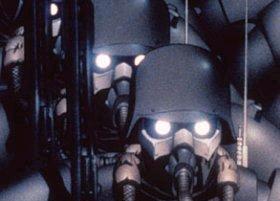Jin Roh: The Wolf Brigade


Anime is hugely popular in Japan and has a growing fan base in America. However, most anime titles appear in video stores, not on the big screen. It's fairly rare to see an anime movie (even rarer to see one not dubbed) in movie theaters, which is why Jin Roh: The Wolf Brigade seems an odd choice for release. Well, maybe not, since it's writer, Mamoru Oshii (In the Aftermath, Mrs. Pepperpot) directed the legendary Ghost in the Shell. On a broad, stereotypical level, people enjoy anime for a number of reasons including complex stories, detailed mecha, fantasy, or even sex. Jin Roh falls into another category, one of boredom.
One supposes that director Hiroyuki Okiura intended for Jin Roh to be an introspective, thoughtful movie, but he puts so much mood into it that it lumbers along at a plodding pace. The movie takes place in an alternate past, a decade after Germany won World War II. In Tokyo, the police battle with guerillas with suicide bombs. Kazuki Fuse (voiced by Michael Dobson, Free Willy 3: The Rescue, Night Warriors) is part of the Special Unit, an elite group of policeman. Fuse meets on of these suicide bombers, a young woman dressed like Little Red Riding Hood. He hesitates before shooting her, allowing her to detonate the bomb, which has larger ramifications. In the subsequent months, Fuse is haunted by the girl, At her grave, he meets Kei Amemiya (voiced by Moneca Stori), and the two begin a tentative relationship/friendship with each other, seeking comfort in each other over Kei's sister's death.
It takes an awful long time to get here, and then the plot bogs down in a hopelessly confusing jumble of politics, dreams, and conspiracy. Fuse dreams about a young girl chased by wolves. The bombing causes Fuse's superiors to keep a close eye on him. People may not be who they seem. Everything is dull and no one can understand what is going on. Okiura and Oshii add in lots of labyrinthine politics, never making things interesting enough to merit one to pay attention. If it's any consolation, the animation is dark and moody, befitting the mood that Okiura wanted to establish. He makes excellent use of fog to add atmosphere to the scenes and to describe the clouded nature of the story.